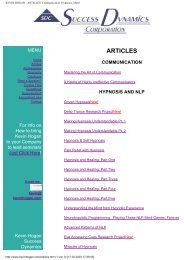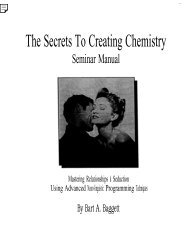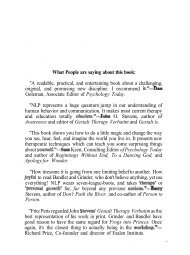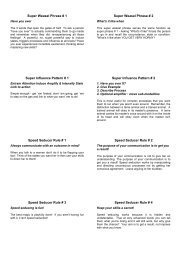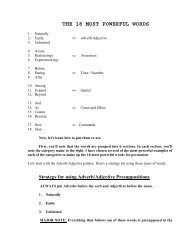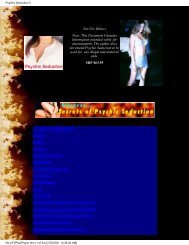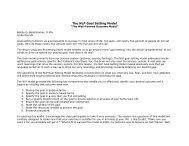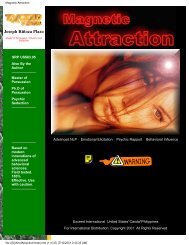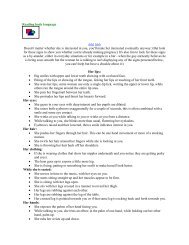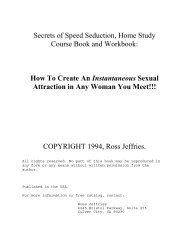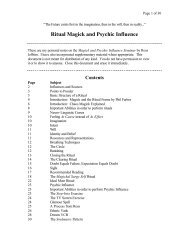A Pragmatic Guide To Communication & Change.pdf - NLP Info Centre
A Pragmatic Guide To Communication & Change.pdf - NLP Info Centre
A Pragmatic Guide To Communication & Change.pdf - NLP Info Centre
- No tags were found...
You also want an ePaper? Increase the reach of your titles
YUMPU automatically turns print PDFs into web optimized ePapers that Google loves.
produce miscommunication and misunderstanding become, instead, tools for even<br />
deeper and more profound communication. The more astute we become at seeing,<br />
hearing, and feeling the total messages being sent, the better able we will be to perceive<br />
what is really meant. This awareness will also enable us to better use our own channels<br />
of communication to express what we need and want, not only to others, but also within<br />
ourselves.<br />
This book is a presentation of various models of human behavior. These models can be<br />
extremely useful as tools when used to understand, predict, and shape the human<br />
interactions we call communication. But these models can also be very limiting if we<br />
forget that they are not actually reality. We must keep in mind the idea stated so well by<br />
Edward T. Hall:<br />
All theoretical models are incomplete. By definition, they are abstractions and therefore<br />
leave things out. What they leave out is as important as, if not more important than, what<br />
they do not, because it is what is left out that gives structure and form to the system. (p.<br />
14) Beyond Culture<br />
CHAPTER II<br />
THE COMMUNICATION CATEGORIES MODEL<br />
Sorcerers say that we are inside a bubble. It is a bubble into which we are placed<br />
at the moment of our birth. At first the bubble is open, but then it begins to close<br />
until it has sealed us in. That bubble is our perception. We live inside that bubble<br />
all of our lives. And what we witness on its round walls is our own reflection.<br />
Don Juan, from Carl.. Castaneda, Tales of Power<br />
Representational Systems<br />
Perception is an exciting area of study in the field of psychology. As discussed in the<br />
previous chapter, because neurological input forms the building blocks of our models of<br />
the world, there are many different ways to describe the process we call perception. What<br />
follows is based on the neurological model presented in Chapter 1.<br />
There are five primary ways humans experience the world. Barring neurological<br />
damage, we can see, feel, hear, smell,<br />
28<br />
It is important when you are learning the basic principles of effective communication to<br />
drop the assumption that you already know what words such as those listed above mean.<br />
Your "knowing" is based on your own model of the world which is also subject to the<br />
processes of generalization, deletion, and distortion, as well as to neurological, social, and<br />
individual constraints. Rather than presuming that your understanding of these words is<br />
the same as the speaker's, it is often advisable to ask for his own definitions. This may<br />
keep you from becoming trapped by your own model of the world. By more fully<br />
understanding what the speaker is saying, you are more likely to gain rapport and be more<br />
influential in your communication with him. Specific techniques for asking for a person's<br />
definitions of these words as well as some linguistic clues for when more information is<br />
needed are given in Chapter III.<br />
Summary<br />
... we are looking for pragmatic redundancies; we know that they will not be<br />
simple, static magnitudes or qualities, but patterns analogous to the<br />
mathematical concept of function.... (p. 41)



